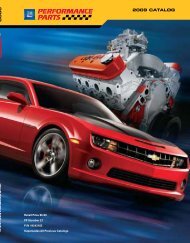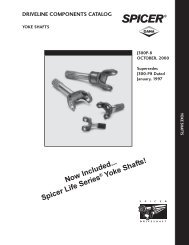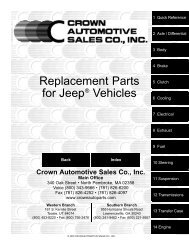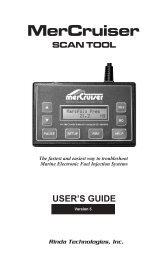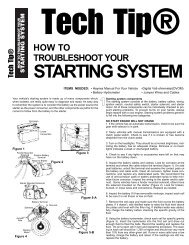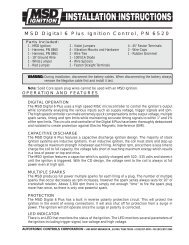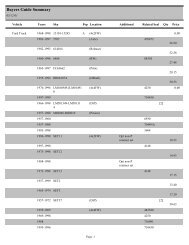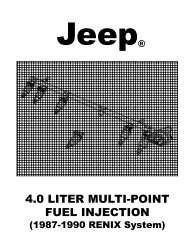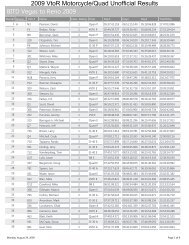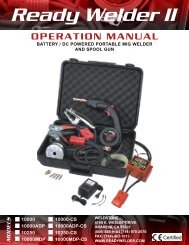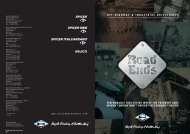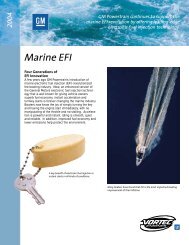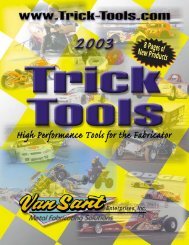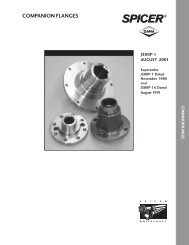Ball and Roller Bearings - Ntn-snr.com
Ball and Roller Bearings - Ntn-snr.com
Ball and Roller Bearings - Ntn-snr.com
You also want an ePaper? Increase the reach of your titles
YUMPU automatically turns print PDFs into web optimized ePapers that Google loves.
External bearing sealing devices<br />
Type Seal construction Name Seal characteristics <strong>and</strong> selection considerations<br />
Non-contact seals Contact seals<br />
Oil<br />
surface<br />
For dust proof<br />
Slinger<br />
Slinger<br />
Z grease seal<br />
V-ring seal<br />
Metal conduit<br />
Lip edge<br />
Oil <strong>com</strong>b<br />
sleeve<br />
Oil flow<br />
Air flow<br />
Spring<br />
Seal lip<br />
For preventing<br />
lubricant leakage<br />
Oil <strong>com</strong>b sleeve<br />
<br />
<br />
<br />
<br />
<br />
<br />
<br />
Internal slinger<br />
<br />
<br />
<br />
<br />
<br />
<br />
External slinger<br />
Z grease seal<br />
<br />
<br />
<br />
<br />
<br />
<br />
<br />
V-ring seal<br />
<br />
Oil seal<br />
In this design, lubricating oil that<br />
makes its way out of the housing<br />
along the shaft is thrown off by<br />
projections on the oil <strong>com</strong>b sleeve<br />
<strong>and</strong> recirculated.<br />
<br />
<br />
<br />
By providing a slinger inside the<br />
housing, centrifugal force guides<br />
the lubricant flow back on the<br />
bearing <strong>and</strong> helps prevent it from<br />
dirtying the work environment. <br />
<br />
<br />
By mounting a slinger on the outside<br />
of the housing, centrifugal force<br />
helps to prevent dust <strong>and</strong> other solid<br />
contaminants from entering.<br />
Cautionary points regarding selection<br />
By installation on the revolving<br />
shaft, these seal types make use<br />
of centrifugal force to aid<br />
lubrication, seal in lubricant, <strong>and</strong><br />
prevent the entrance of<br />
contaminants.<br />
<br />
Installation of a slinger inside the<br />
housing further enhances the<br />
sealing in of lubricants.<br />
<br />
Installation of a slinger on the<br />
outside of the housing will provide<br />
greater protection against dust<br />
<strong>and</strong> other bearing contaminants.<br />
<br />
These seal types are <strong>com</strong>monly<br />
employed together with other<br />
sealing devices.<br />
In cross section resembling the letter "Z," this seals empty spaces are filled with<br />
grease.<br />
The seal is <strong>com</strong>monly used with a plummer block (bearing housing).<br />
<br />
<br />
<br />
<br />
<br />
This design enhances sealing efficiency with a lip that seals from the axial direction.<br />
With the aid of centrifugal force, this seal also offers effective protection against<br />
dust, water, <strong>and</strong> other contaminants entering the bearing. Grease can be used on<br />
both sides of the seal.<br />
At seal peripheral speeds in excess of 12 m/s, seal ring fit is lost due to centrifugal<br />
force, <strong>and</strong> a clamping b<strong>and</strong> is necessary to hold it in place.<br />
Oil seals are widely used, <strong>and</strong> their<br />
shapes <strong>and</strong> dimensions are<br />
st<strong>and</strong>ardized under JIS B 2402.<br />
In this design, a ring-shaped spring<br />
is installed in the lip section. As a<br />
result, optimal contact pressure is<br />
exerted between the lip edge <strong>and</strong><br />
shaft surface, <strong>and</strong> sealing<br />
efficiency is good.<br />
When the oil seal <strong>and</strong> the bearing<br />
are in very close proximity, internal<br />
bearing clearances are sometimes<br />
too small to ac<strong>com</strong>modate the<br />
additional heat generated by<br />
friction between the seal <strong>and</strong> shaft.<br />
In addition to considering the heat<br />
generated by contact seals at<br />
various peripheral speeds, internal<br />
bearing clearances must also be<br />
selected with caution.<br />
Depending upon the direction in<br />
which the lip faces (in toward the<br />
bearing or away from the bearing)<br />
contact oil seals are very effective<br />
at preventing lubricant leakage<br />
from the housing or contaminants<br />
from infiltrating the bearing.<br />
Cautionary points regarding selection<br />
Shaft surface roughness (reference)<br />
<br />
Peripheral<br />
Surface roughness<br />
speed m/s<br />
Ra Rmax<br />
<br />
50.8a 3.2s<br />
<br />
5100.4a 1.6s<br />
<br />
100.2a 0.8s<br />
<br />
Shaft material (reference) <br />
<br />
Machine structural<br />
Material carbon steel Low carbon<br />
alloy steel Stainless steel<br />
Surface<br />
hardness<br />
Processing<br />
method<br />
HRC 40 or higher necessary<br />
HRC 55 or higher advisable<br />
Final grinding without<br />
repeat (moving), or buffed<br />
after hard chrome plating<br />
Allowable speed/temperature according to seal type/material (reference)<br />
Allowable<br />
Seal type/material peripheral speed m/s V(m/s) d(mm)n(r/min)<br />
Allowable temp ˚C<br />
60,000 <br />
Oil seals<br />
Z-seal<br />
V-ring<br />
Nitrile rubber<br />
Acrylic rubber<br />
Fluorinated rubber<br />
Nitrile rubber<br />
Nitrile rubber<br />
16 or less<br />
26 or less<br />
32 or less<br />
6 or less<br />
40 or less<br />
-25 +120<br />
-15 +150<br />
-30 +200<br />
-25 +120<br />
-25 +120<br />
A-79



